Composting Tea ( Leaves)
In recent years there has been much criticism of the use of plastic in teabags (see below) and the advice given is that where possible use loose tea, just in case the publicity has led to some deciding it is not worth the bother of composting tea it is worth reemphasising just how good used tea can be as a nutrient for the garden. Lawrence Hills in Grow Your Own Fruit and Vegetables, first published in 1971 by Faber and Faber, made the case for adding tea to the compost heap and nothing has changed apart from the fact that if tea bags are composted they should be plastic free, be torn open and emptied or the remains of plastic bags rescued after composting.
As with other kitchen waste it is best to collect the cooled tea leaves (or bags) after each pot or mug of tea, in a kitchen caddy along with other vegetable waste and only make the trip to the compost bin or worry when the caddy is full.
The leaves contain about half as much nitrogen as dried blood and more than poultry manure. Tea leaves contain approximately 4.4% nitrogen, along with, 0.24% phosphorus and 0.25% potassium the addition of tea to the compost heap will provide nutrients encouraging the decomposition process. All teas are not the same each variety of tea, black, green or red, will contain a different ratio of compounds but whichever you prefer they will make a useful addition to the compost bin particularly if collected in larger quantities from a local tea shop or café.
Tea leaves, and tea bags, can be added direct to the soil tea as mulch on the soil surface round the plants or to dig the leaves into the soil when preparing the plot. However, as a composter I would recommend composting rather than direct application as it saves time to treat the tea as any other compostable kitchen waste. One of the disadvantages in direct application is that the Tannic acid is in the tea can in some soils lower the pH, so it would be advisable to check the soil pH before the addition of tea leaves.
Photo
By Selena N. B. H. from Fayetteville, USA (English Westminster
Uploaded by JohnnyMrNinja) [CC BY 2.0 (https://creativecommons.org/licenses/by/2.0
)], via Wikimedia Commons"
Tea and Plastics in teabags
The loose tea brewed in a teapot or tea ball can be easily composted. Tea leaves are a good source of Nitrogen (Greens) organic material for the compost bin which will be moistened during the brewing process encouraging decomposition. The tea ball or strainer can be emptied directly into the kitchen caddy while loose leaves can be scooped from the pot into the caddy by hand, once cool.
Teabags are usually listed as compostable items but in recent years more and more composters have complained that the bags do not actually decompose when composted. In 2010 a report by Which? Gardening, found that six out of the seven largest tea bag manufacturers did not make fully compostable bags. This is because at the bags include a non-biodegradable plastic (polypropylene) so that they can be more easily heat-sealed during manufacture. The bags may be described as “70% or 80%” compostable which includes the tea leaves and paper element of the bag but not the plastic.
Although each individual teabag is small they account for about 150 tonnes of polypropylene going to landfill, AD or composting a year in the UK alone. This is equivalent to about 165 million teabags a day. Many of these are composted in food waste.
Before the current concerns about plastic in teabags the advice when home composting was to use loose leaf tea or if using teabags that did not decomposing during the composting process i.e. non-compostable bags:
- tear open the bags before putting them in the bin
- or sieve or pick them out after composting.
But this has now changed so to avoid the risk of the plastic entering the home compost bin, and eventually the soil, the bag should be emptied by cutting the top off the bag and tipping the tea residue into the kitchen caddy allowing it to be treated as loose tea. Unfortunately, if the empty bag is put into the household (landfill) rubbish bin the plastic will still enter the soil.
OIL BASED PLASTIC-FREE TEA BAGS
Mike Armitage a gardener from Wrexham started a petition to get manufacturers to remove all plastic from tea bags after finding residue from teabags in his garden compost. Details of the 38 Degrees petition can be found at (https://you.38degrees.org.uk/petitions). The petition succeeded in persuading the UK's largest tea bag manufacturer Unilever/PG Tips to announce that they will remove plastics from their teabags.
Some teabags are already free from oil-based plastic and some of the bags can be home composted.
Fruit, herbal and green tea ranges may already use a compostable tea bag material which can be put straight in the compost bin.
Composting "Plastic Free" Tea bags
The new plastic-free tea bag paper is biodegradable and compostable to industrial standards. The used tea bags may be accepted in the food waste container provided by your local council where such a scheme is operated.
Compostable teabags made of a corn starch (SOILON) will usually hot compost in about 6-8 weeks around 12 months in a cold composting system. The corn starch might be from GM plants so there will be a need to compare the risks to the environment from the GM seeds from which the corn was grown with that from microplastics which is killing ocean life now as well as cropping up in soil and fresh water.
Tea bags revisited
Following the publicity in 2018 relating to plastic in tea bags resulting in difficulties composting the bags and the more serious issue of microparticles of plastic getting in the soil and ground water I have revised the topic to see what progress has been made. The original 2018 entries have been left on this page for reference.
The situation regarding Plastic free teabags is confusing as many manufacturers seem to be describing products as plastic free where they contain plastic from biological sources rather than a petroleum-based source. The bioplastic is usually made for corn starch and it seems the use of such materials will increase. These are regarded by some scientists as a plastic. (The clue might be in the name).
The UK Plastics Pact, encourages the switch to “compostable” materials for teabags.
So it is important to check the manufacturers web-site and the product label in order to avoid trying to home compost material which will require industrial composting so as to avoid contaminating the soil, water course and seas by trying to home compost unsuitable plastic.
A report by Katie Wright for BBC News on 6 November 2019 ((https://www.bbc.co.uk/news/uk-50260687) and an Item in the Independent was the basis for the follow summary published a summary of the situation.
Brew Tea uses cornstarch in their bags. All the boxes of tea are plastic-free and contains a plastic-free tea card which explains the types of material used to pack the tea and the best way to recycle them.
Clipper describes its teabag as “plastic free” but they are made of bio-plastic a plant-based bio-polymer". The actual bags made from abaca plants, are unbleached, organic and Fairtrade,
Hampstead Tea whole leaf home compostable pyramids are made GM-free sugar starch. The inner plastic-look pouch that holds the tea is also home compostable in about 90 days.
PG Tips is still planning to move to "fully biodegradable teabags" and has already produced one billion
Pukka does not heat-seal the edges of teabags, using an organic cotton stitch of and folding process to seal the bags. The tea bags can be home composed. It individually wraps each teabag and it expects all its blends to be in its new recyclable envelope by the end of 2019.
Teapigs, the "tea temples” contain the bio-plastic PLA from corn starch arebiodegradable bags. The clear box “plastic” inner natureflex bag is compostable
Tetley teabags still contain a small amount of plastic material (0.04g per bag) It anticipates beginning to introduce fully biodegradable teabags for its core ranges in 2020
Twinings pyramid tea bags are made from maize starch but each bag has a label attached that is covered in plastic and will need to be removed before composting. Twinings traditional teabag range should be using bioplastic rather than oil based from 2020,
Some of its "tag" teabags are plastic free being made from a plant-based paper material that is folded and stitched with cotton
We Are Tea The tea bags are 100% plastic free and 100% biodegradable. They are made from SOILON, a biproduct of corn starch. The teabags are sealed by ultrasound (not glue) and do not have tags. They can be home composted, but it will take at least 18 months.
Teabag decomposition in a Wiggo pod wormery.
We have been running a series of experiments comparing the decomposition rates of various plant material in a Wiggo Pod wormery. The primary purpose is to provide photos for free use by composters giving talks, schools, etc.
This set of photographs shows the decomposition of a PG tips tea bag (which contains plastic to assist in heat sealing of the bag, and fruit tea teabags
Composting and Microplastic particles in soil
In the past the main concerns when composting teabags were based on the fact that the uncomposted teabags looked unsightly spread on the garden but now the main problem relates to the presence of microplastic resulting from degradation of plastic in the teabags. Joining other plastic-coated items in the soil and in drainage water.
A recent study* has shown that earthworms can be play a significant role in transporting microplastics in soils by means of their casts, burrows, etc with the smaller particles being carried to a deeper depth. This may increase the risk of the microplastic entering groundwater. As treating the soil with compost as a mulch tends to attract worms the risk to groundwater should be borne in mind when diposing of teabags and the subsequent treatment after use.
Using compost as a mulch is good for plant health and in attracting worms to the treated area but other research** has shown that polyethylene microplastics in plant litter deposited on the soil surface resulted in reduced worm growth and higher mortality. Would the same results be seen if a mulch of compost contaminated with plastic microparticles from a significant quantity of “plastic” teabags was used in the compost.
But it is not just teabags there are other plastic-coated items that might find their way into the compost bin, or council waste stream, that can produce microparticles. Check the label, do not confuse home compostable products with those compostable at an industrial site. Compostable products such as those containing PLA (poly-lactic acid) do not contain petroleum-based plastics and will decompose to form healthy compost.
It has now been shown that microplastics in soil can sinificantly reduce the population of ants, mite and nematodes. Mites, roundworms, springtails and other micranthropods and nematodes in the soil which play and essential role in the soil food web recycling carbon and nitrogen as well as aiding decomposition in the soil are threatened by oil-based synthetic waste. In some cases the most common speciesof orbital mites where reduced by 15%, Diptera fly larvae by 30%, and insect larvae (Lepidoptera) by 41% with a 20% reduction in nematodes.
We can all play a small part in protecting our environment by reducing plastic polution in our gardens.
References and background source:
*Microplastic transport in soil by earthworms” by Matthias C. Rillig, Lisa Ziersch & Stefan Hempel Scientific Reports volume 7, Article number 1362(2017)
** Earthworms on a microplastics diet Julia Fahrenkamp-Uppenbrink Environ. Sci. Technol.10.1021/acs.est.5b05478 (2016). http://science.sciencemag.org/content/351/6277/1039.1/tab-article-info
Plus
The Environmental Hazards Inherent in the Composting of Plastic-Coated Paper Products WILL BRINTON1 , CYNDRA DIETZ2 , ALYCIA BOUYOUNAN2 , DAN MATSCH2 http://www.ecocycle.org/files/pdfs/microplastics_in_compost_white_paper.pdf
The following while not related directly to composting might be of interest.
Microplastics: Premium teabags leak billions of particles - study
https://www.bbc.co.uk/news/world-us-canada-49845940 27 September 2019
Microplastics in compost
A study by Nicolas Weithmann and colleagues from the University of Bayreuth, Germany investigated the potential of organic fertilizers from biowaste fermentation and composting as an entry path for microplastic particles into the environment.
All samples from plants converting biowaste to fertiliser. (composts, digestates, and percolate-leachates from digestion, which is used as liquid fertilizer) contained plastic particles, but amounts differed significantly with substrate pre-treatment, plant, and waste (for example, household versus commerce)
Composters will be concerned to know that 20-24 pieces of microplastics per kg of dry weight were found in the compost from a composting plant processing biowaste from households with green clippings from the area. While waste from the public using the green waste collection system is much more likely to be contaminated than home composted material it does indicate an are of potential concern.
However, the quantity of microplastic present was small when compared with compost produced from supermarket waste which contained 895 pieces >1 mm per kg dry weight.
Read more
Rachel Ehrenberg (April 5, 2018). “Microplastics may enter freshwater and soil via compost.” Science News
Reference
Weithmann, N., et al. (2018). “Organic fertilizer as a vehicle for the entry of microplastic into the environment.” Science Advances (published online April 4, 2018).
Plastic in compost and soil from ground cover fabric
Weed control by covering the ground with a material to exclude light e.g. plastic sheet, cardboard and newspaper, old carpets or groundcover fabric is effective, at least for a year or two, saves the effort of digging and does not disturb the fabric soil.
Using organic material such as cardboard is effective and environmentally sound practice. However, using plastic ground cover sheeting may not be desirable if we are trying to avoid plastic contamination of the soil and water courses. On allotments such sheeting may be used as a weed suppressant on vacant plots and under woodchip paths.
It can also introduce long strands of black plastic to the compost bin. The photos show strands found in an allotment community composting bin.
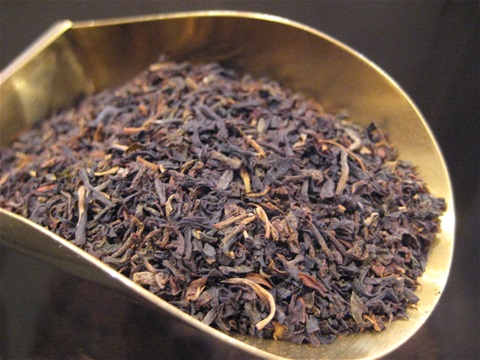
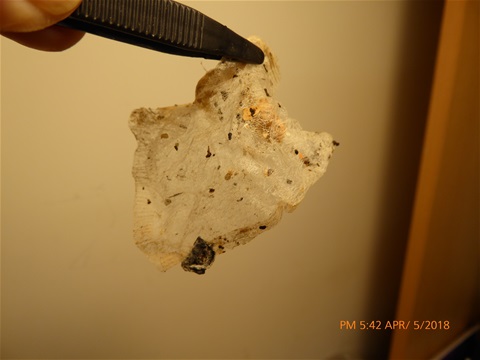
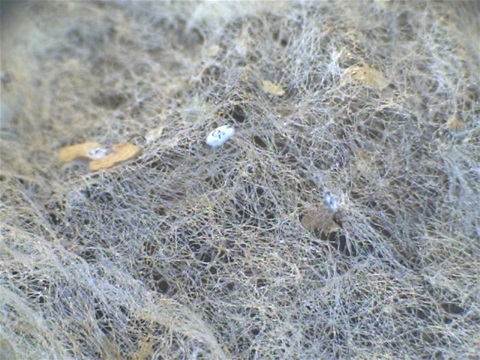
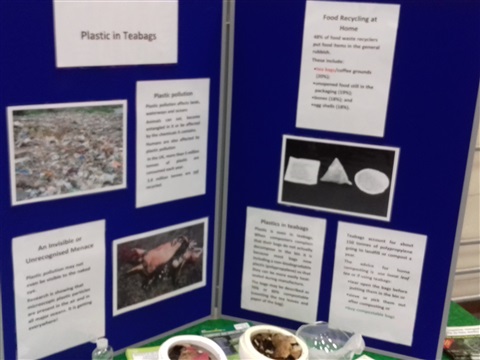
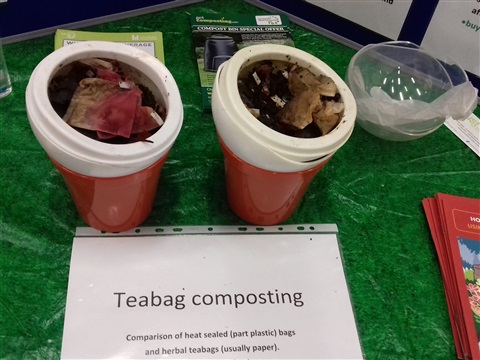
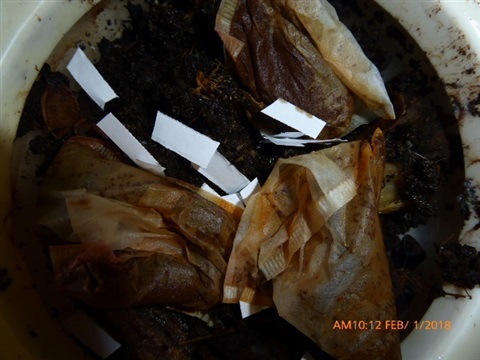
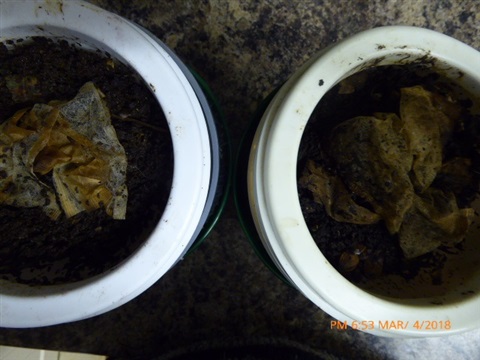
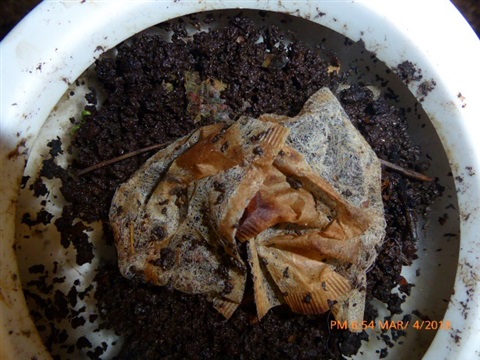
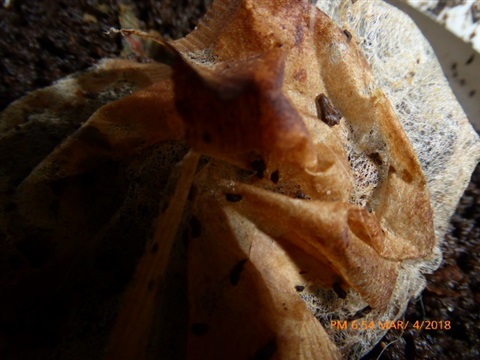
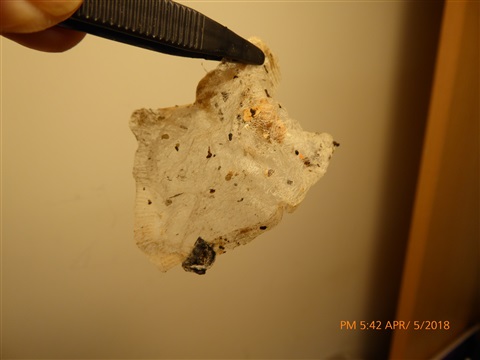
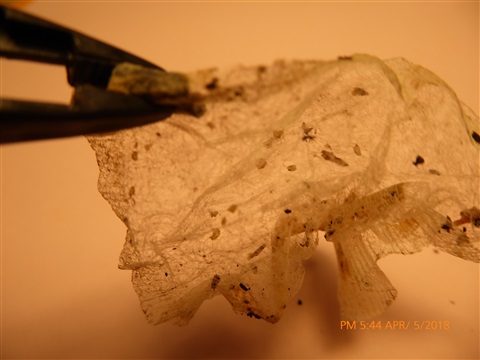
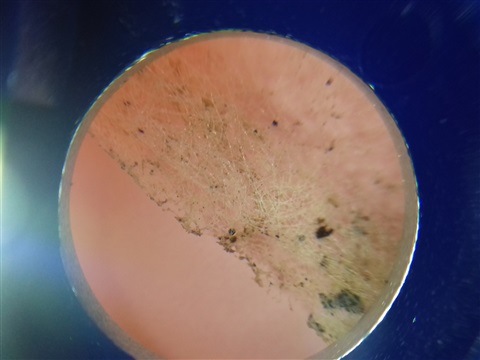
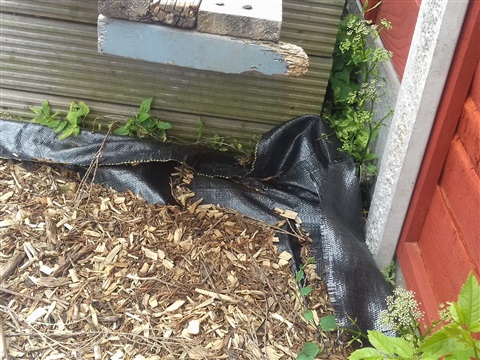
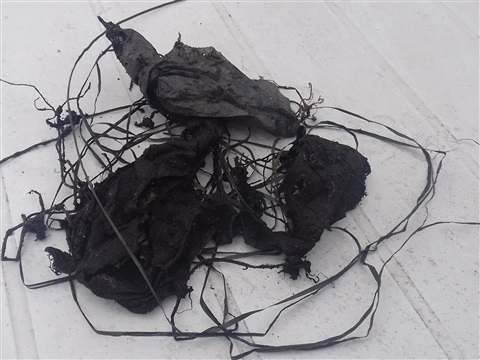
Mrs. Jennie Reed
A lot to think about. Thankyou
John Byrne
Great website! The previous Clipper paper tea bags composted well in my wormery. Does anyone know if the new Clipper PLA bags will compost in the wormery?